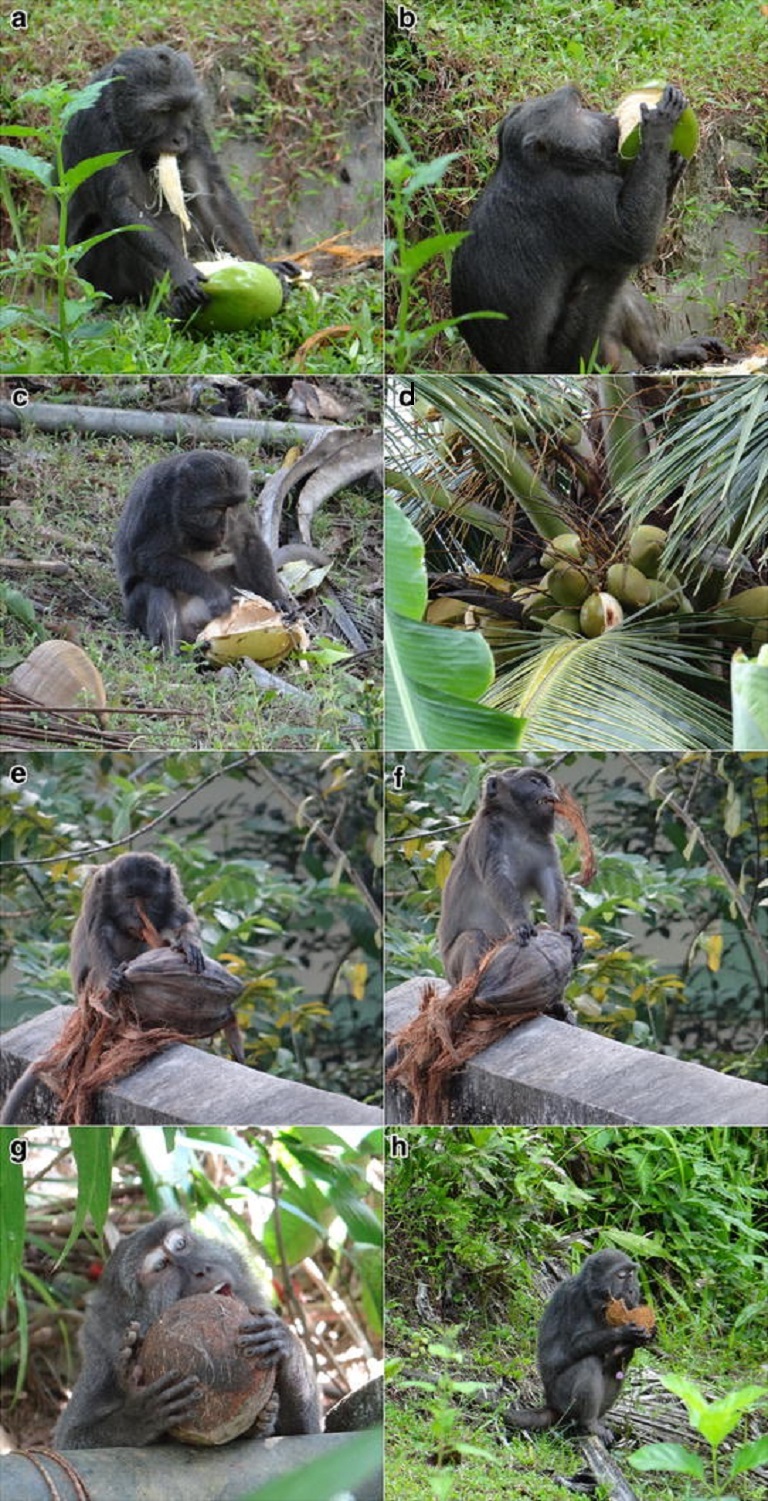- A study on Nicobar long-tailed macaques shows they have high levels of sensorimotor skills and intelligence.
- They are experts at eating hard-to-open coconuts.
- They floss their teeth after eating. Only two other macaques across the globe are known to floss.
When a Nicobar long-tailed macaque feels hungry, it looks for the most easily available food in its vicinity – a coconut – and handles it dexterously to get the white meat from inside. They de-husk using hand and teeth. When the inner brown shell becomes sufficiently exposed, they pound it on a hard surface until the outer shell cracks open and take out the white meat. Once hunger is taken care of, the macaques don’t rest. After all, there is a pressing need for oral hygiene. These long-tailed macaques from Nicobar floss their teeth after eating. They use a twig, a thin metal wire, a piece of coir or even a sharp grass blade as dental floss.
NLT macaques use multiple foraging techniques. Video edited by Eddie Roqueta / Mongabay, from footage shot by the research team.
Teeth flossing in Macaques are rare. Only two other types of macaques across the globe, the Japanese macaques and the Thai long-tailed macaques, are known to do it. Indian macaques have never been seen doing it before.
It is the same story with the macaque’s ability to pry open a coconut. Very few macaques, such as some populations of rhesus macaques and some Balinese macaques are known to eat coconut. Even the pigtail macaques (also called coconut harvesters), who on the bidding of their owners climb a tree to pluck a coconut and give it to their owners, are never inspired to crack the nut open and eat it.
This foraging-related behaviour is demonstrative of “a high level of sensorimotor skills and intelligence,” said Honnavalli N. Kumara, one of the scientists involved in studying the foraging techniques employed by the Nicobar long-tailed (NLT) macaques. Kumara and his colleagues studied these macaques for a period of three years to arrive at their conclusions. Four PhD students tailed a group of macaques in Campbell Bay (a village in Nicobar) everyday for the entire three-year period. They have published their findings in the journal Primates.
The NLT macaque is endemic to three islands in the Andaman and Nicobar Archipelago – Great Nicobar, Little Nicobar and Katchal. These macaques have not been studied much in the past. However, a population survey on macaques, done right after the 2004 Asian Tsunami, had shown a sharp decline in their number. A substantial chunk of coastal habitat occupied by these macaques was lost in the tsunami. The scientists wanted to know how the species had fared in the subsequent years? Much to their delight they found that the population had bounced back.

“In the aftermath of the tsunami the macaques were forced to move inland and adapt,” said Kumara. While some groups moved deeper into the forests others started living on the periphery of villages and human settlements. One such group, living in proximity of humans, was the subject for the study on the foraging behaviour in macaques. It comprised three adult males and eight adult females a couple of adolescent males and some infants and juveniles.
The scientists found that the NLT macaques were ‘generalist’ feeders – they ate a variety of food. They also engaged in a range of complex behaviour to make their food easily accessible and palatable. For example, if some food was covered with thorns, hair or mud, they would wipe it clean with a leaf, a cloth or a polythene sheet before consuming it. They were also seen cleaning their food by rubbing it between their palms or sometimes by washing the food item in a water hole to get rid of the muck.
When interested in eating insects hiding under vegetation, the macaques were seen to vigorously shake the vegetation to flush out the insects, making it easier to catch them. The scientists call this vigorous shaking of plants ‘beating the bush.’ The fact the NLT macaques engage in something like beating the bush, indicates that they have a “conceptual understanding of the hiding places of the insects,” noted the paper.
In the repertoire of foraging techniques displayed by NLT macaques, “beating the bush to obtain insects appears to be novel to the Nicobar macaques, which is fascinating,” said Andie Ang a primatologist and the vice-president of the Jane Goodall Institute – Singapore. Ang was not associated with this study.
These foraging techniques have allowed the NLT macaques to survive despite a major habitat alteration in the 2004 tsunami. In fact, in the years after the tsunami the macaques’ dependence on coconuts has increased. This is causing coconut farmers much distress as they lose a substantial part of their harvest to the macaques. The farmers are now raising an alarm, and “have even complained to forest departments officials, asking for compensation,” said Kumara.
However, he is hopeful that the study will not only help improve our understanding about these highly intelligent species of macaques but also help address management aspects, such as conflicts with farmers, more effectively.

Citation:
- Pal, A., Kumara, H.N., Mishra, P.S., Velankar, A.D., & Singh, M. (2017). Extractive foraging and tool-aided behaviours in the wild Nicobar long-tailed macaque (Macaca fascicularis umbrosus). Primates, doi:10.1007/s10329-017-0635-6.













